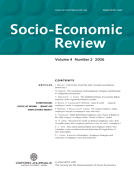-
Views
-
Cite
Cite
Paul Willman, Alex Bryson, Rafael Gomez, The sound of silence: which employers choose no employee voice and why?, Socio-Economic Review, Volume 4, Issue 2, May 2006, Pages 283–299, https://doi.org/10.1093/ser/mwl012
Close - Share Icon Share
Abstract
Whether employees have ‘voice’ at work is determined, in large part, by employers' decisions as to whether to adopt a ‘voice’ regime. In Britain during the 1980s and 1990s, the employer's decision was largely unconstrained by the law. Under these conditions, we argue that whether an employer adopts a voice regime turns on employers' perceptions of the net benefits of worker voice to the firm. This is confirmed in empirical analyses that point to independent associations between ‘no voice’ and workplace size, organizational complexity, industrial sector and workforce composition. We show that the size and composition of the ‘no voice’ sector has remained constant over the past two decades.




